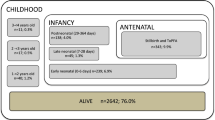Abstract
Objective: This study was carried out to identify the trend and the frequency of neural tube defects from July 1998 to June 2004.Methods; A total of 310 babies were born with neural tube defects with the overall frequency of 5.7/1000 births compared to 2.3/1000 births observed earlier in our hospital.Results : The most common defect was spina bifida (54.8%) followed by anencephaly (31.6%), and encephalocele (11.6%). More neural tube defects were observed in female and low birth weight babies, still births and unbooked mothers. Neural tube defect was significantly higher among babies born to parents of consanguineous marriage (p<0.01). Associated congenital defects were observed in thirty nine (12.6%) cases.Conclusion: The rise in the frequency of NTDS may indicate the current trend of NTDs in Southern India. A further prospective study is desired to measure the effectiveness of regular folic acid supplementation in bringing down this frequency
Similar content being viewed by others
References
Agarwal SS. Neural tube defect. A preventable congenital malformation.Indian Pediatr 1999; 36: 643–648.
Kulkarni ML, Mathew MA, Ramachandran B. High incidence of neural tube defects in South India.Lancet 1987; 1260.
Sharma AK, Upreti M, Kamboj M, Mehra P, Das K, Misra Aet al. Incidence of neural tube defects of Lucknow over a 10 year period from 1982-1991.Indian J Med Res 1994; 99: 223–226.
Kalra A, Kalra K, Sharma V, Singh M, Dayal RS. Congenital malformations.Indian Pediatr 1984; 21: 945–950.
Kulkarni ML, Mathew MA, Reddy V. The range of neural tube defects in southern India.Arch Dis Child 1989; 64: 201–204.
Bhat BV, Babu L. Congenital malformations at birth-A prospective study from south India.Indian J Pediatr 1998; 65: 873–881.
Airede KI. Neural tube defects in the middle belt of Nigeria.J Trop Pediatr 1992; 38: 27–30.
Windham GC, Edmonds LD. Current trends in the incidence of neural tube defects.Pediatrics 1982; 70: 333–337.
Seller MJ. Unanswered questions on neural tube defects.British Medical journal 1987; 294:1–2.
Agarwal SS, Singh U, Singh PS, Singh SS, Das V, Sharma Aet al. Prevalence and spectrum of congenital malformations in a prospective study at a teaching hospital.Indian J Med Res 1991; 94:413–419.
Sood MN, Agarwal N, Verma S, Bhargava SK. Neural tubal defects in an east Delhi hospital.Indian J Pediatr 1991; 58: 363–365.
Dowd MJ, Connolly K, Ryan A. Neural tube defects in rural Ireland.Arch Dis Child 1987; 62: 297–298.
Stevenson AC, Johston HA, Steward MIP, Golding DR. Congenital malformationsa report of a study of series of consecutive births in 24 centers.Bull WHO 1966; 34(suppl):l-127.
Naderi S. Congenital abnormalities in newborns of consanguineous and nonconsanguineous parents.Obstct Gynecol 1979; 53:195–199.
Sharma PD. The incidence of major congenital malformations in Mysore.Indian J Pediatr 1970; 37: 618–619.
Lakshminarayana P. Evaluation of Genetic and Environmental Factors in Pregnancy loss and malformed fetus. Final Report DST No. SP/SO/B-38-91, Department of Science and Technology New Delhi, 1998.
Szepfalusi Z, Seidl R, Bernert G, Dietrich W, Spitzauer S, Urbanek R. Latex sensitization in spina bifida appears disease-associated.J Pediatr 1999; 134: 344–348.
Edwards MJ, Shiota K, Smith MSR, Walsh DA. Hyperthermia and birth defects.Reprod Toxicol 1995; 9: 411–425.
Sharma JB, Gulati N. Potential relationship between dengue fever and neural tube defects in a northern district of India.Int I Gynaecol Obstct 1992; 39: 291–295.
Botto LA, Moore CA, Khoury MJ, Erickson JD. Neural tube defects.Nezv Eng J Med 1999; 341:1509–1519.
Alasdair-Hunter GW. Neural tube defects in eastern Ontario and Western Quebec. Demography and family data.Am J Med Genet 1984; 19: 45–63.
MRC Vitamin Study Research Group. Prevention of neural tube defects: results of the Medical Research Council Vitamin Study.Lancet 1991; 338: 131–137.
Czeizel AE, Dudas I. Prevention of the first occurrence of neuraltube defects by periconceptional vitamin supplementation.N Engl J Med 1992; 327:1832–1835.
Author information
Authors and Affiliations
Corresponding authors
Rights and permissions
About this article
Cite this article
Mahadevan, B., Bhat, B.V. Neural tube defects in pondicherry. Indian J Pediatr 72, 557–559 (2005). https://doi.org/10.1007/BF02724177
Issue Date:
DOI: https://doi.org/10.1007/BF02724177




